Abstract
Wood quality has been an ongoing concern for science, having become increasingly important in the current context, in which the demand for wood is increasing and forest fires are more frequent and violent. This study aims to evaluate the quality of wood in trees affected by fires and the negative impact of these phenomena on the speed of wood degradation, as a result of weakening the trees due to the action of stress factors. The study was carried out using modern techniques on beech trees (Fagus sylvatica L.) remaining in an area affected by a litter fire in 2017. Measurements were taken with the Arbotom Rinntech sound tomograph, the IML Resi F-500S resist graph, and the Pressler core sampler to observe the quality of the wood inside the trees. It was found that all the trees were in various stages of decay, the tomograms being able to characterize the severity of decay only in the case of fully decayed wood as a result of the action of xylophages fungi, whose harmful influence is more pronounced when the injuries sustained by the trees are higher. Although the trees attempted to close the fire wounds through their own defense mechanisms, the destructive action of the fungi intensified with time. After the forest fires, for an effective assessment of the wood’s internal quality, the resist graph can be used. For valuable trees, one could use the tomograph, but the measurements have to be taken only by qualified operators.
1. Introduction
The impact of fire on the environment is closely linked to the existence of humans and the way they chose to use fire [1,2,3,4,5,6]. Forest fires are caused by either natural causes (lightning), in various proportions ranging from small [1,7] to big worldwide [8,9], or by human actions [2,4,5,6,7,10,11]. The ignition and especially the development of a fire are influenced by factors such as climatic characteristics of the area (maximum temperatures, relative air humidity, wind [1,2,6,7,9,12,13,14]), the topographic features of the area (inclination and exposure of the slopes, fragmentation of the land [3,4,12,15]), and characteristics of fuels [4,12,13,16,17,18]. In the forests, almost everything in, on, and above the ground can represent fuels [6], whose combustibility and inflammability may depend on their type, dimensions and humidity, spatial distribution (underground, aerial fuel), vertical and horizontal continuity [16,17], specific surface area, density, structure, and chemical composition [13,16,19].
The impact of fires on trees is closely related to the characteristics of each individual tree, which takes into account the stage of development (seedling/young tree/mature tree/old tree [20,21]), the diameter at breast height, the crown volume, but also the shape and thickness of the bark [22] and the density of the wood [6,20], respectively. A tree with a large diameter at breast height and a well-developed crown is more likely to survive after a litter fire, as long as it was not a violent one [22]. In addition, the thickness of the bark is another element of the tree’s self-protection against external factors, including fires [21,22]. A thick bark protects the layers of wood inside [6,22,23,24], including the cambial zone that contains the entire tree supply system with nutrients and mineral salts, which provides the tree with the necessary elements for survival [25,26]. The density of the wood decisively controls the burning process and, consequently, the impact of the fire on the further development of the tree, because wood with a higher density burns slower than that with a lower density [6,19].
In the case of litter fires, the trunk and its base are the most affected by the fire, especially in the direction of fire advance [19]. The effects of fire on the trunk differ depending on the type and severity of the fire, the quantity of fuels around the tree, trunk diameter, bark thickness, and the presence of defects or wounds in the area [19,27]. Practically, the area with the most valuable wood in the tree can be degraded to a greater or lesser extent [19,20,27,28,29,30,31].
On the other hand, extreme phenomena such as forest fires and catastrophic storms (hurricanes, typhoons) are increasingly frequent and more devastating, and they also affect trees in various regions [4,32,33,34,35], leading to the loss of important amounts of wood or to its downgrading [31]. To reduce to some extent the economic losses due to the downgrading of wood [36,37], a series of more or less invasive methods have been perfected over time that aim to assess the quality of wood in standing or felled trees [31,34,36,37,38]. Among them, destructive methods, such as those based on the use of growth core borers and the Shigometer, require a lot of time and interfere with the structure of the trunk, which can lead, over time, to some internal degradation [34,37,39]. There are also invasive methods that are considered relatively non-destructive, such as those based on resist graphs, which measure the resistance of wood to a drill by the amplitude determined as a result of passing a thin drill through the wood. These were mainly used to evaluate urban trees [37], but nowadays, they are increasingly used to determine some physical characteristics of wood, such as density and growth [36,39], being increasingly used in forestry by forest owners, forest administrators, and wood processing companies [37,38].
The quality of the wood in standing trees can also be assessed by non-destructive methods (NDE), such as those based on X-ray devices [37] or sound waves [31,34,39], which can directly or indirectly measure the quality of wood on smaller samples, logs, or even trees [31]. In this category are included the Fakopp sound meter and the sound tomograph, devices that are based on the speed and time of flight of the sound waves through the wood (TOP), according to which assessments can be made regarding the presence of internal defects, the structure and uniformity of the wood, and even its density [31,34].
As the non-destructive evaluation of wood is the key to solving practical problems regarding the quality of the wood, without destroying its integrity [40,41], the aim of the paper was to evaluate the quality of the wood inside the trunk of the remaining beech trees in a plot affected by a litter fire in 2017, to see to what extent the internal decay is directly due to the fire or to the time. For achieving this aim, the following objectives were formulated: (i) to visually inspect the trees affected by fire to see to what extent the external defects could influence the internal quality, and to investigate the internal quality of wood using the sonic tomograph, the resist graph, and the Pressler core sampler; (ii) to evaluate the range of sound wave speed in relation to the quality of wood and relative resistances to drilling; (iii) to evaluate if the quality of wood inside the trunk could be a direct consequence of the fire or was an indirect one, due to the passing of time and to the weakening of trees as a result of fire.
2. Materials and Methods
2.1. Study Area
The research was carried out in compartment 149 (Figure 1), managed by the Runcu Forest District (Gorj County Forest Administration, Romania), a forest privately owned by the Plaiul Vălari Municipality, which was affected by a litter fire in 2017 (Figure 1). Compartment 149 has an area of 34.7 ha and is located at an altitude between 700 and 1100 m a.s.l., being a beech stand with an average age of 93 years. The fire occurred in the mountain area of Gorj County and affected more than 180 ha of forest in several compartments. It was caused by the fire spreading from agricultural land bordering the forest. Due to the difficult terrain conditions and the limited accessibility of the area, the fight with the fire lasted five days.

Figure 1.
Location of research (processing according to [42,43]).
2.2. Methodology
The field research was carried out six years after the forest fire (2017). Immediately after the fire, the trees which showed the greatest degradation (burned trunks and burned roots)were harvested. After a visual inspection of the affected forest, it was noted that there were trees with different signs of degradation on the trunk and roots. In order to have data for all the encountered situations, from the trees left in the forest, 21 were chosen for the measurements. The majority of them (17 trees) presented external signs or degradation which was caused by the fire; two of them presented other defects on the trunk (frost-cracks) and two did not showed any external signs of being affected by fire, so they were considered non-affected trees.
In order to assess the internal quality of the wood, investigations were carried out with the Arbotom Rinntech sound tomograph (Arbotom Rinntech v.2, Heidelberg, Germany), at 50 and 100 cm above the ground, resulting in two measurements taken on a given tree. Depending on the results obtained from the summary interpretation of the tomograms, additional measurements were taken on the relative resistance of the wood to drilling, evaluated with the help of the IML Resi F-500S resist graph (IML-Intrumenta Mechanik Labor System GmbH, Wiesloch, Germany), as well as growth cores, which were taken with the Pressler core sampler, having a depth of 40 cm.
The Arbotom sound tomograph comes equipped with 24 sensors, of which a smaller number of sensors is commonly used (Figure 2). They are placed on the trunk, at a given level, in a horizontal plane, distributed in such a way as to best capture the shape of the trunk at that level. The sensors were placed at distances small enough to capture all the details. The collected data were imported into the tomograph software (Arbotom Rinntech 3-D Impulse Tomograph Version for Microsoft Windows 98, 2000, XP, Vista and Windows 7), so the section illustrated by the tomograph resembled the cross-section of the trunk at the analyzed level [24,44,45].

Figure 2.
An example of sound wave propagation and the reconstructed tomogram in the case of investigated trees: (a) sound wave propagation from the transmitting sensor (S1) to the receiving sensors; (b) the image provided by the tomograph with the connections between the sensors, colored differently in relation to the transfer speeds of the sounds; (c) the matrix of average speeds calculated between transmitter–receiver sensor pairs; (d) the reconstructed tomogram based on sound transfer speeds through the wood, where the numbers around the section represent the number of sensors used in the measurement.
Following the completion of data entry into the software, the actual determination started. Each sensor was hit with a hammer with similar force consecutively. The number of hits was chosen according to the ambient noise in the area, following the guidance of the literature [44,45,46,47]. Seven hammer hits were applied to each sensor, and the errors of sound wave transfer from the emitter sensor to the receiver sensors were kept below 7% during the process.
The sensors placed on the trunk act as both a transmitter and a receiver. When a sensor is hit, a sound wave propagates from it to all other sensors (Figure 2a). When the next sensor is hit, it transmits the sound wave to all other sensors acting as receivers [24]; this action was repeated for each consecutive sensor. As the sounds were emitted and received by the paired sensors, the tomograph adjusted the colors of the connecting lines based on the sound speed between sensors. Then the software constructed spider web-like image with the links between the sensors, colored differently according to the sound speed (Figure 2b). Based on a matrix of average sound transfer speeds between transmitter–receiver sensor pairs (Figure 2c), the software reconstructed a colored tomogram [48] that characterized certain areas (Figure 2d).
For an easier understanding of the impact of sound wave speeds on wood quality, we calculated the descriptive statistical indicators (minimum, maximum, average, and median values) and the speed was categorized in five groups (smaller than 500 m/s, 501–1000 m/s, 1001–1500 m/s, 1501–2000 m, and greater than 2000 m/s).
Based on the tomograph results, points for further measurements carried out with the resistograph IML F-500 Resi were selected. This instrument measures the relative resistance of wood to drilling in the direction of advance of a drill [49], with a length and a diameter of 50 cm and 3 mm, respectively. The presence of oscillations, as well as increased resistances, indicates healthy wood, while much reduced resistances (close to zero) indicate an advanced state of decay [50,51]. It has to be mentioned that the IML Resi F-500S used in the determinations was produced in 2011 and it does not have internal memory to register the results, for which reason the interpretation of the resistograms was conducted by the operator, without the possibility of using specific software for interpreting the results.
To have a complete image of the wood quality inside the trunk, we also collected growth cores with a Pressler drill, having a length of 40 cm, at the same points and in the same directions used for the measurement with the resist graph.
3. Results
Analyzing all the 42 tomograms sourced by the 21 beech trees, it was found that most of the trees were affected by fire to some extent. Summary statistics of sound propagation speed are shown in Figure 3a,b. It can be observed that a high amplitude between the sound speeds was registered. For example, at the height of 50 cm above the ground, the maximum value was recorded for tree no. 12, at 3673 m/s, and the minimum value was recorded for tree no. 2, at 59 m/s. At the 100 cm level, the maximum values were measured for tree no. 2 (3554 m/s) and tree no. 11 (3374 m/s), while the minimum was registered for tree no. 7 (300 m/s).
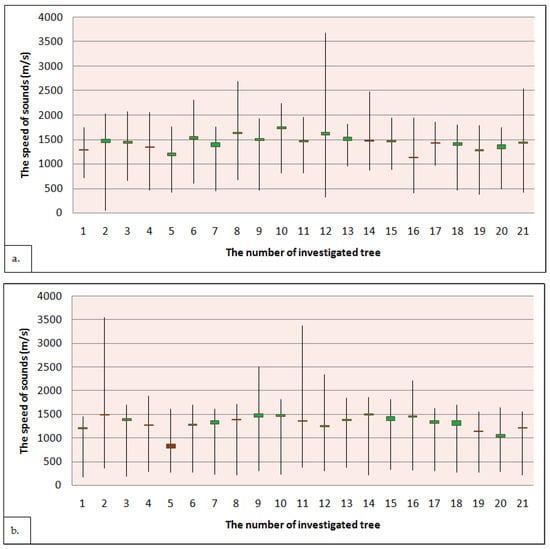
Figure 3.
The descriptive statistics for the speed of sound through the wood at 50 cm above the ground (a) and 100 cm above the ground (b).
Because a single extreme value cannot characterize the entire section, it is important to know the distribution of speed transfer and which one predominates. The values were grouped into categories and are presented in Figure 4 and Figure 5 for the level situated at 50 cm, respectively, at 100 cm above the ground.
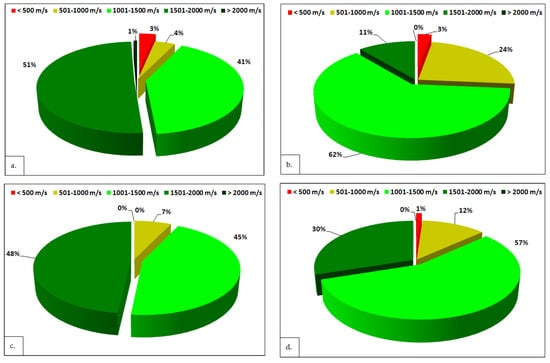
Figure 4.
The distribution of sound wave speeds registered at 50 cm above the ground: (a) tree no. 2; (b) tree no. 5; (c) tree no. 11; (d) tree no. 20.
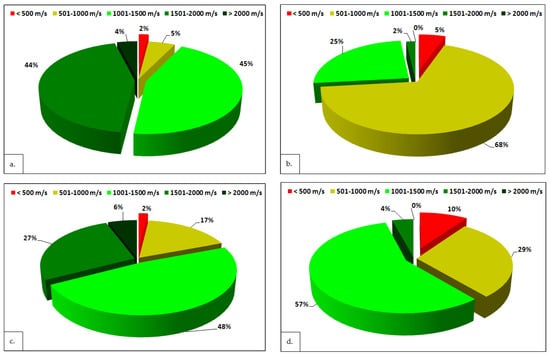
Figure 5.
The distribution of sound wave speeds registered at 100 cm above the ground: (a) tree no. 2; (b) tree no. 5; (c) tree no. 11; (d) tree no. 20.
By analyzing Figure 4 and Figure 5, some differences can be observed between the two levels. Thus, in trees 5 and 20, in the case of the first section (50 cm), it can be seen that speeds greater than 1000 m/s predominate, while in trees no. 2 and 11, speeds greater than 1500 m/s predominate (Figure 4). For the level situated at 100 cm above the ground, the distribution of speeds was slightly changed, especially at tree no. 5, where values between 501 and 1000 m/s (Figure 5) predominate, which shows a reduction in wood density, translated by smaller sound wave speeds.
Some tomograms indicate healthy wood in both analyzed sections, as is the case with trees no. 1, 7, 10, 13, 15, 17, 18, and 19 (Figure 6). On other trees, differences from section to section appeared (trees no. 3, 8, 14, 16, and 21—Figure 7), because in these trees, the base of the trunk was affected by fire. So, the tomograms for the section situated at 50 cm above ground indicate some areas with low speeds and internal modifications of the wood structure. Most of these areas were located in a north-northwest direction. This was similar to trees no. 2, 9, 11, and 20 (Figure 8), but in these cases, the affected section is located at 100 cm above the ground. In addition, there were some trees for which the tomograms indicated low speeds and structural problems of the wood, for sections located both at 50 cm and 100 cm above the ground (trees no. 4, 5, and 12—Figure 9).
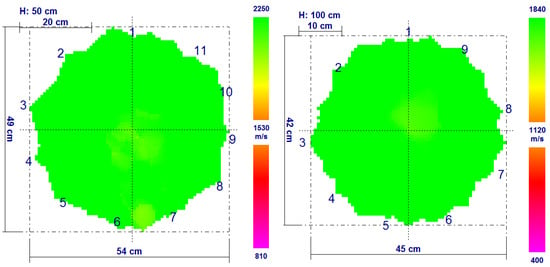
Figure 6.
Healthy wood in both analyzed sections (trees no. 1, 7, 10,13, 15, 17, 18, and 19), tree no. 10 as example, where the numbers around the section represent the number of sensors used in the measurement.
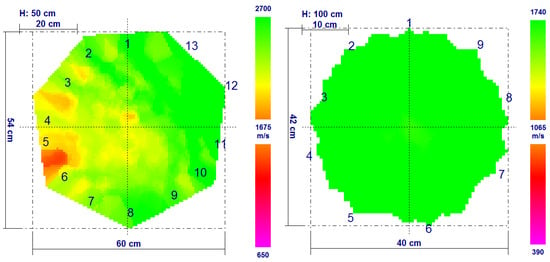
Figure 7.
Degradations identified by the tomograph at 50 cm above ground (trees no. 3, 8,13, 14, 16, and 21), tree no. 8 as example, where the numbers around the section represent the number of sensors used in the measurement.
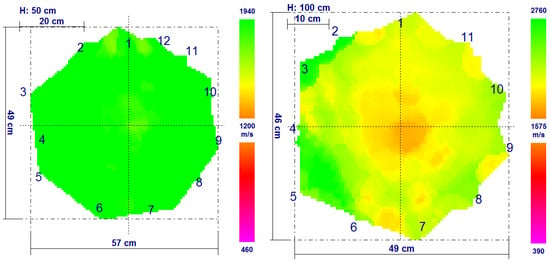
Figure 8.
Degradations identified by the tomograph at 100 cm above ground (trees no. 2, 9, 11, and 20), tree no. 9 as example, where the numbers around the section represent the number of sensors used in the measurement.
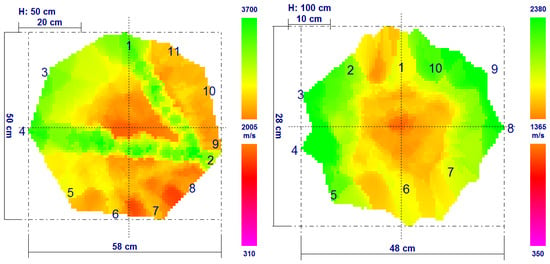
Figure 9.
Degradations identified by the tomograph at both investigated levels (trees no. 4, 5, and 12), tree no. 12 as example, where the numbers around the section represent the number of sensors used in the measurement.
Tree no. 2 showed defects at the base of the trunk and on the roots in the east-southeast area, which indicated both the scorching and falling of the bark, as well as the presence of some fungi (in the eastern part—Figure 10). After carrying out the measurements at the level of 100 cm, it was observed that a big part of the tomogram appeared brightly colored in shades of orange (Figure 11). But when the tomogram was analyzed according to the speed scale specific to the determination, it was observed that those colors corresponded to values over 1500 m/s. Analyzing the resistogram taken in the direction of sensor S8, at the level of 100 cm (Figure 12), it was found that the relative resistance to drilling was reduced and had a low variation, after which the latter started to increase, and a very large variations recorded towards the center of the tree. Comparing the resistogram with the growth core taken with the Pressler drill, it was observed that on the same depth (6–7 cm), wood degradation appeared, after which the wood was healthy. A closer analysis of the growth core (Figure 12) indicated the presence of the red heartwood, which explained the very large and sudden variations in the relative resistance to drilling. On the other hand, the presence of the red heartwood in this tree, a defect that cannot be identified from the visual analysis of the trunk, can also justify the high transfer speed of sound through the wood.
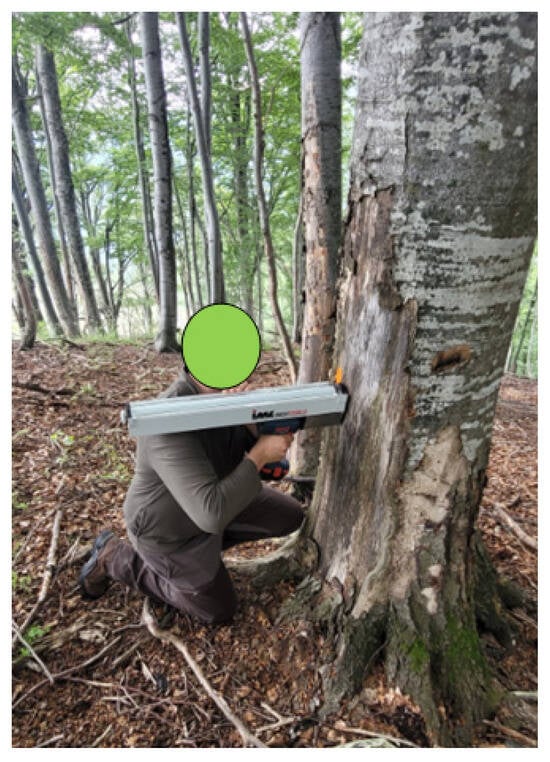
Figure 10.
Visible external defects on tree no. 2.
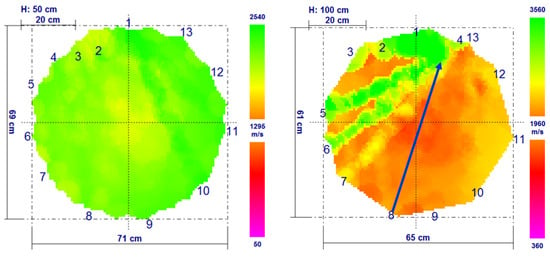
Figure 11.
The investigations carried out at the level of 50 and 100 cm above the ground, in tree no. 2, where the numbers around the section represent the number of sensors used in the measurement.

Figure 12.
The resistogram and the growth core extracted from the direction of sensor S8 at the 100 cm level, in tree no. 2.
Tree no. 5 presented a very suggestive external aspect regarding the impact of the fire on it. The direct influence, which consisted of dry and/or fallen bark from the trunk, affected the trunk in the northeast-southeast direction (Figure 13). In addition, with the passage of time, the impact of the fire could be also seen indirectly, through longitudinal cracks visible on the surface and the occurrence of various necrotic areas and fungi. The tomogram taken at the level of 50 cm above the ground rendered a series of internal irregularities in the northeast direction, corresponding to the surface between sensors S1 and S4, where the speed was less than 1000 m/s, and even decreased to 424 m/s between sensors S3-2 and 447 m/s between sensors S3-4. Even if these speeds were very low, and the tomogram showed areas with inhomogeneous wood and low density between sensors S2-3-4, the image of the tree in that area was much more suggestive, indicating the presence of rot that affected the wood. At the 100 cm level, things look worse on the tomogram (Figure 14), where almost all sound emitted by sensors S1, S2, S3, and S4 registered values lower than 850 m/s, while values higher than 1000 m/s were found only in 13 cases, only one of these speeds exceeding 1500 m/s. From the 100 cm level, in the direction of sensor S8, a growth core was also taken after a resistogram was previously made.

Figure 13.
Visible external defects on tree no. 5.
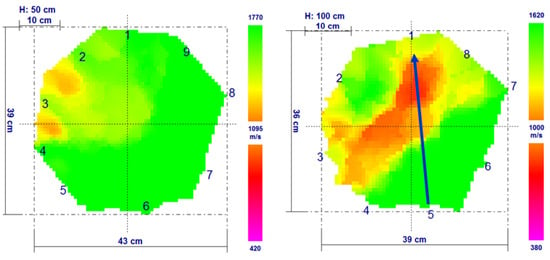
Figure 14.
The investigations carried out at the level of 50 and 100 cm above the ground, in tree no. 5, where the numbers around the section represent the number of sensors used in the measurement.
From the analysis of Figure 15, it was observed that in the first 16 cm, the wood was deeply affected by rot, an aspect also illustrated in the resistogram, through the very low resistances and no variations. Then, the relative resistances to drilling increased. Although no significant oscillations occurred, the growth core showed wood affected by decay, but to a much lesser extent compared to the rest of the sample.

Figure 15.
The resistogram and the growth core extracted from the direction of sensor S8 at the 100 cm level, in tree no. 5.
Tree no. 11 was not affected by the fire to a very large extent, presenting only in the northeast direction an area with dead wood, with fallen bark and with scarring tissues on either side of the affected area. Above the deadwood area, the bark was dry and cracked, but the entire defect does not affect a large trunk height (Figure 16).
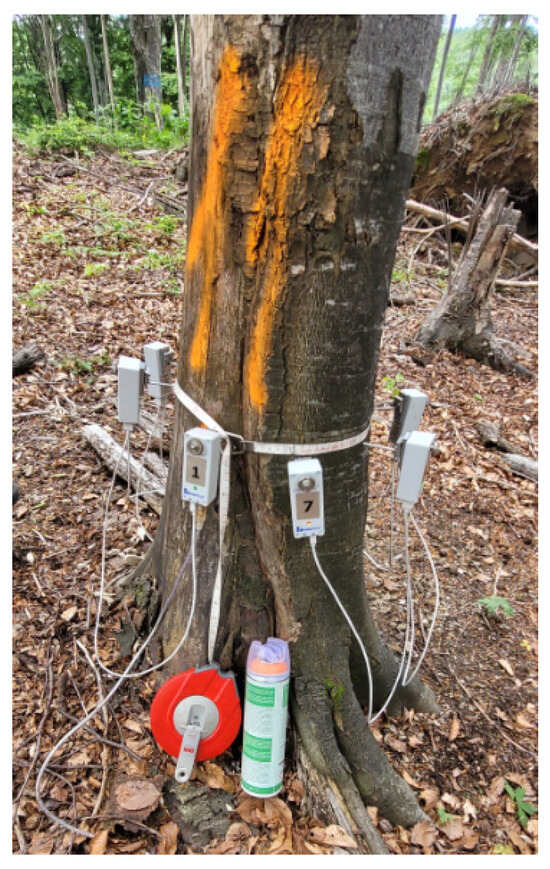
Figure 16.
Visible external defects on tree no. 11.
The analysis of the tomogram made at 50 cm indicated transfer speeds higher than 1500 m/s, so, broadly speaking, healthy wood. But there were some areas with irregularities between sensors S8-1-2, justified by the lower speeds of the sounds transferred between these sensors. At the level of 100 cm above the ground, the same situation appeared as in tree no. 2, where the transfer speeds of sounds between sensors S3-4 were very high (S3-4 = 2868 m/s and S4-3 = 3374 m/s), which led to intense orange and even red colors on the tomogram (Figure 17). These excessively high speed values were probably due to the fact that the sounds travelled in a tangential direction against the annual rings, in an area with healthy wood. What should be noted, however, is the fact that these high speeds can induce errors in the case of superficial interpretation of the tomogram, without taking into account the speed scale of the measurement and, in addition, they can mask lower speed values [40]. Thus, it was found that to and from sensors S8-1-2 and even S3, most speeds do not exceed 1000 m/s, and even a value of 384 m/s appeared between sensors S7-8. The resistogram taken in the direction of sensor S1 at the 100 cm level (Figure 18) crossed the entire section of the trunk. So, it can be observed that in the first 9 cm, the resistances were lower, even reaching half the value of the relative resistances to drilling recorded in the rest of the resistogram. This indicated healthy wood, characterized by significant oscillations and high relative resistances to drilling of the wood from the rest of the trunk. The growth core showed no clear signs of wood decay, but the wood does not appear as dense in the first few centimeters of the sample as compared to the rest of the core.

Figure 17.
The investigations carried out at the level of 50 and 100 cm above the ground, in tree no. 11, where the numbers around the section represent the number of sensors used in the measurement.

Figure 18.
The resistogram and the growth core extracted from the direction of sensor S1 at the 100 cm level, in tree no. 11.
Tree no. 20 was affected by the fire to a rather large extent, which led to a weakening of resistance to stress factors, with negative consequences for the development and, of course, for the quality of the wood. At the time of field data collection, the tree was in an advanced state of decay, showing areas with dead wood and dry and cracked bark (Figure 19), and numerous occurrences of fructifying bodies of xylophage fungi, in the northeast direction, at a high trunk height.
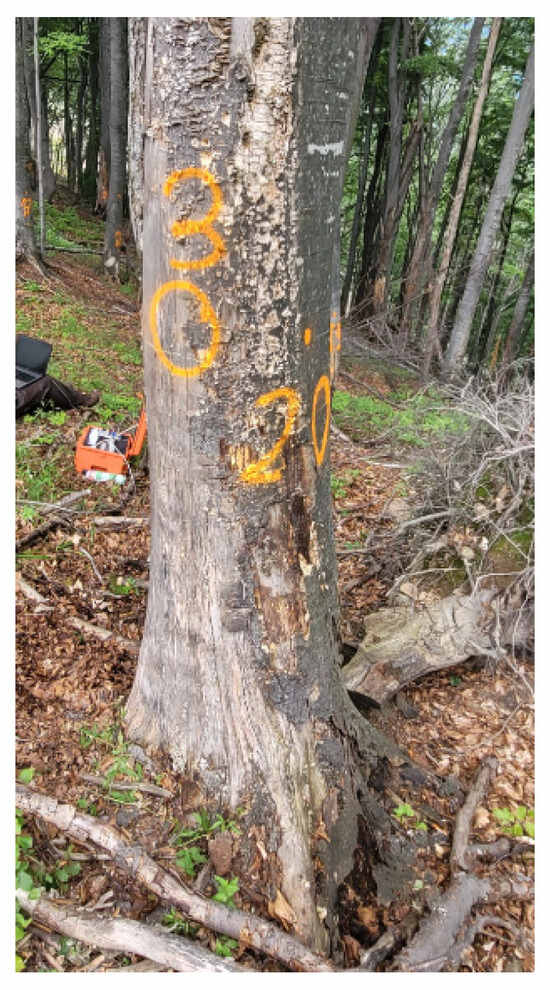
Figure 19.
Visible external defects on tree no. 20.
At the level of 50 cm above the ground, the tomograph recorded sound transfer speeds of 492–878 m/s between the nearby sensors. Otherwise, the tomogram indicated healthy wood. On the tomogram (Figure 20) was noted the presence of internal irregularities in the area opposite to sensors S1 and S5, therefore in the north-south direction, especially towards the outer part of the trunk. Basically, the areas on the tomogram colored in yellow-green, yellow, and various shades of orange were characterized by speeds close to 1000 m/s, but clearer results were illustrated by the resistogram and the growth core (Figure 21). As a result of analyzing the resistogram and growth core taken in the direction of sensor S3, from the 100 cm level (Figure 21), it was observed that in the first 5 cm, there are no variations in the relative resistances to drilling, which means that the structure of the wood was completely destroyed. Then, the resistances began to increase slightly up to 16 cm of the length of the resistogram, even though there were no high relative resistances to drilling, nor the normal variations within the annual rings. Accordingly, in this area, the wood was in an advanced stage of decay, but the cell walls were not completely destroyed.

Figure 20.
The investigations carried out at the level of 50 and 100 cm above the ground, in tree no. 20.

Figure 21.
The resistogram and the growth core extracted from the direction of sensor S3 at the 100 cm level, in tree no. 20, where the numbers around the section represent the number of sensors used in the measurement.
As can be seen, the speeds varied very much. So, for a correct image of the quality of wood inside the trunk, it was important to analyze the tomograms according to the speed scales, proper for each investigation. In addition, the mechanical resistance, which takes into account the geometric shape of the section and the recorded speeds of the sounds, was very different from section to section. So, it could be seen that the most affected were tree no. 11 at the level of 100 cm (−43% in the south-southeast direction), tree no. 2 at 100 cm (−36% north-northeast), tree no. 12 at the level of 50 cm (−34% north), and trees no. 3 at 50 cm (−30% east).
4. Discussion
From the analysis of the literature [2,4,6,12,13,15,52] it was found that the risk of forest fires increases with proximity to human settlements or areas where people carry out agricultural activities. The same thing happened in the present case, when the fire was initiated by a resident who wanted to clear his agricultural land of dry vegetation. As has happened countless times, fires started by people get out of control and end up affecting forested areas [12,53]. This aspect should raise a number of questions because, according to what was said by Medour-Sahar et al. [7], “the persistence of a cause of fire production over time means that this is part of the culture of the respective people”.
In this study, it was observed that the impact of the fire on the trees occurs predominantly in the north, east, and south directions, in relation to the configuration of the land, which showed that these effects were more serious in the direction from which the fire developed [54]. Although the study area has a west-southwest aspect, the fact that it is strongly fragmented influenced the way and the direction of fire development. The aspect has also been pointed out by other researchers [1,2,4,12,18], who mention that, along with the type of vegetation, the topography of the land can play a very important role in the development of a fire. Thus, it was found that where the trees had micro-hollows (small depressions) nearby, they were much more affected by the fire due to the plant debris that accumulated in those areas and maintained the fire for a longer period of time, a conclusion at also reached Harvey and Visser [55].
The destructive action of fire affected all parts of the tree. In this regard, the trunk had, depending on the species, a much greater resistance to fire. Also, it could be affected by fire due to its cambial zone located close to the surface [6,56]. Related to this, in the studied stand, it was observed that the defects related to the fire consist of dry and cracked or fallen bark from the base of the trunk and the superficial roots affected by the fire. The defects identified on the trees, as a consequence of the fire, do not seem to have very clear effects on the speed of sound propagation through wood. They seemed to influence the future development of the tree and the probability that the tree was colonized by fungi, which definitely had impact on sound speed in the wood [48]. In this regard, Rodriguez and Silva et al. [20] mention that the resistance of the tree to the action of fire is also influenced by the thickness of the bark, in the sense that thicker bark can defend the cambial zone much better. In other words, to understand, as a whole, the impact of fire on wood and the subsequent development of fire-affected trees, one must know the way of growth and structure of wood [22]. This is very important, because wood is the result of a biological process conditioned by a wide range of factors with genetic and environmental influences, which can leave their mark on wood properties [27,57,58].
The trees affected by the fire in the studied area often show dead wood and areas without bark, but most of them without scarring tissues. This can be partly explained by the fact that the fire affected both the thin, smooth, and rhytidome-free beech bark and the cambial zone [48,54], which led to the loss of the ability to create scar tissues and cover the affected area [27].
Regarding the measurements taken with the resist graph and growth cores, it must be mentioned that a similar protocol has been used in the research of Tomczak et al. [37], who investigated Quercus robur trees in Poland, and Downes et al. [36], who compared the results regarding the basic density of Pinus radiata wood obtained by the use of IML Power Drill resistograph and the SilvaScan on the wood samples. In this study, the growth core accurately illustrated the actual condition of the wood inside the trunk, while the resistogram provided information on the relative resistances to drilling [47,49,50,59]. Normally, healthy wood is denser and has higher resistances to drilling, with variations induced by latewood and earlywood being easily visible, since these have different densities [26,27,56,60]. In this regard, Downes et al. [36] and Gendvilas et al. [38] mention the existence of a strong correlation between the resistances recorded by the resist graph and the basic density of the wood.
New generation devices allow settings regarding the advance speed of the drill through the wood and the number of rotations per minute [38]. However, using the instrument in this study, it was only possible to set the number of rotations of the drill corresponding to the species (1200 RPM [61], value specific to hardwood species). Regarding the advance of the drill through the wood, in the manual of the IML Resi F-500S resist graph [61], it is mentioned that the device has a variable advance speed, according to the level of pressure exerted on the acceleration. In the study of Gendvilas et al. [38], who evaluated pine trees (Pinus caribaea var. hondurensis and Pinus elliotti var. elliotti) from six locations in Australia, the tools was set at 3500 RPM and 200 cm/minute. Downs et al. [36], who investigated Pinus radiata trees in Oregon (U.S.A.), have set the instrument at 200 cm/minute and 250 RPM. On the other hand, in hardwood species, a reduction in the advance speed of the drill and an increase in the number of rotations is required, as in Tomczak et al. [37], who worked with Quercus robur trees, and set the resist graph at 50 cm/minute and 1500 RPM.
The instrument used in this study outputs data on hard support, which disables the interpretation of data with specific software, a feature which is integrated in newer models [36,37], and which allows us to accurately determine the range in resistance. However, resistance is also measured in percent [36,37,38], and the interpretation of those data was made by the operator according to the scale on the chart. Red heartwood was identified both in the growth core and also in the resistogram in tree no. 2, through the increased relative resistances to drilling and the large amplitude of the variations between the resistances. This was due to the fact that this abnormal coloring of the central part of the trunk in beech, as it is called by Beldeanu [56] and by Câmpu [62], presented a much higher wood hardness. Some authors [56,59,62] consider the red heartwood of the beech false heartwood, giving this area the properties specific to the heartwood. Thus, the formation of heartwood involves chemical transformations that lead to a higher wood density by impregnating the cell walls with a series of organic substances and mineral salts that give them greater resistance [56,62].
The lack of oscillations in the annual rings, even in conditions of relatively high resistance to drilling, can only indicate internal changes that lead to a relative uniformity in the wood, by destroying the denser areas, corresponding to the latewood [27,49,59], which was consistent with resistograms taken from trees no. 5, 11, and 20. On the other hand, the lack of resistance indicates internal voids or rotten wood. It is known that the resist graph allows a quick and precise check of wood defects, especially in the case of defects that lead to the weakening of the tissues [37].
Comparing the tomogram made at 100 cm above the ground for tree no. 5 with the resistogram and the growth core taken, it was observed that in the tomogram, the area with low sound transfer speeds does not even start from the surface of the trunk, but it developed towards its periphery from the opposite side, while the resistogram and the growth core indicated rotten wood in the first 12 cm of the samples, after which the wood degradation was no longer so advanced. This can also be seen from a simple visual analysis which indicated that the area between sensors S1 and S4 (i.e., in the northeast direction) was affected by rot to a greater or lesser extent, and even showed bodies of fructification of xylophage fungi (Figure 22).

Figure 22.
Beech trees attacked by xylophage fungi in the study plot.
On the other hand, xylophage fungi that attack wood act both by structural destruction and by increasing humidity in the respective areas [48,56,60,63]. If it is taken into account that the density is closely related to the humidity [31,36,56,58,64] and that sounds have bigger transfer speeds in a dense environment, then, to some extent, sound transfer rates through wood in an early stage of decay can be influenced by increased humidity in the area as a result of fungal action, which would lead to a slightly erroneous assessment of the internal quality of the wood inside, an aspect also indicated by Deflorio et al. [65].
Overall, the severity and characteristics of the fire played the most important role in the subsequent development of the trees and how they managed to close the wounds produced by the fire in the study area. As long as the wounds were superficial (scorched bark) or occupied small areas, the trees themselves could continue to exist in relatively good conditions with minimal impact on wood quality. Conversely, if the wounds produced by the fire affected various parts of the tree (roots, trunk) and had large sizes, the normal development of the tree was affected, since it could not close its wounds in time and became vulnerable to the action of external factors. From this perspective, the wood can be colonized by fungi that lead to the structural destruction of the wood. The action of fungi on wood occurs in stages [56,60,63,65], showing a slower pace at the beginning.
Therefore, the reduction in wood quality can be attributed to the time elapsed from the fire to the time of the measurements, where the trees continued to grow in harsher conditions, due to the weakness created by the fire. Due to the trees’ weakness, fungi found a favorable environment and attacked the trees, a claim also supported by Deflorio et al. [65], who mentions that, if, at first, the fungal activity does not have a great influence on the speed of sound, with the passage of time, the destructive action of the fungi is more and more visible, as found in the reduction in the transfer speed of the sounds through the wood.
5. Conclusions
After the fire, the trees had to fight for survival, and the large wounds could not be covered, with almost non-healing tissue or parenchyma areas to show that the trees were trying to close those huge wounds. The presence of scarring tissues was noticed only in trees very little affected by the fire, with small wounds.
The inability of trees to close fire wounds has made them susceptible to the attack of xylophage fungi, whose action of destroying the structure of the wood can be detected to a small extent with the sonic tomograph in the beginning stages of the attack, but can be identified much more easily in resistograms and growth cores and will become more and more evident, leading to a gradual but clear downgrading of the wood in the most important portion of the trunk from a qualitative point of view.
In addition, from the analysis of all trees, it was observed that the action of xylophage fungi occurs on the outside of the trunk, most of the time, at heights higher than those actually exposed to the fire and, in particular, in trees that had a larger surface area of wood uncovered, exposed to the outside disturbing factors and not protected by the bark.
In order to limit the indirect effects of fires on the quality of wood, it is recommended to harvest the trees from the burned areas as quickly as possible, especially if they show big signs of degradation produced by fires. The reason for this recommendation is that with the passage of time, the degradation will affect the wood quality slowly at the beginning, and more and more quickly after this first stage, so in the end, the wood can be used only as firewood.
Funding
This research received no external funding.
Institutional Review Board Statement
Not applicable.
Informed Consent Statement
Not applicable.
Data Availability Statement
The original contributions presented in the study are included in the article; further inquiries can be directed to the corresponding author.
Acknowledgments
The author would like to thank the Department of Forest Engineering, Forest Management Planning and Terrestrial Measurements, Faculty of Silviculture and Forest Engineering, Transilvania University of Brasov, for the logistics and equipment needed to carry out this study. The author would like to thank George MUSAT and Marian ARIBASOIU, for their great support in collecting the field data.
Conflicts of Interest
The author declares no conflict of interest.
References
- Zumbrunnen, T.; Menéndez, P.; Bugmann, H.; Conedera, M.; Gimmi, U.; Bürgi, M. Human impacts on fire occurrence: A case study of hundred years of forest fires in a dry alpine valley in Switzerland. Reg. Environ. Chang. 2012, 12, 935–949. [Google Scholar] [CrossRef]
- Tian, X.; Zhao, F.; Shu, L.; Wang, M. Distribution characteristics and the influence factors of forest fires in China. For. Ecol. Manag. 2013, 3101, 460–467. [Google Scholar] [CrossRef]
- Arthur, M.A.; Blankenship, B.A.; Schörgendorfer, A.; Loftis, D.L.; Alexander, H.D. Changes in stand structure and tree vigor with repeated prescribed fire in an Appalachian hardwood forest. For. Ecol. Manag. 2015, 340, 46–61. [Google Scholar] [CrossRef]
- Calviño-Cancela, M.; Chas-Amil, M.L.; García-Martínez, E.D.; Touza, J. Interacting effects of topography, vegetation, human activities and wildland-urban interfaces on wildfire ignition risk. For. Ecol. Manag. 2017, 397, 10–17. [Google Scholar] [CrossRef]
- Barbu, I. Riscul de incendii în pădurile din România: Cartare și metode de evaluare. Bucov. For. 2018, 18, 155–163. [Google Scholar] [CrossRef]
- Burlui, I.; Burlui, M.C. Incendiile forestiere: Elemente caracteristice, factori determinanți și măsuri de gestionare. Bucov. For. 2018, 18, 165–175. [Google Scholar] [CrossRef]
- Meddour-Sahar, O.; Meddour, R.; Leone, V.; Lovreglio, R.; Derridj, A. Analysis of forest fires causes and their motivations in northern Algeria: The Delphi method. iForest-Biogeosci. For. 2013, 6, 247–254. [Google Scholar] [CrossRef]
- Stocks, B.J.; Mason, J.A.; Todd, J.B.; Bosch, E.M.; Wotton, B.M.; Amiro, B.D.; Falnnigan, M.D.; Hirsch, K.G.; Logan, K.A.; Martell, D.L.; et al. Large forest fires in Canada, 1959–1997. J. Geophys. Res. Atmos. 2003, 108, 8149. [Google Scholar] [CrossRef]
- Gillett, N.P.; Weaver, A.J.; Zwiers, F.W.; Flannigan, M.D. Detecting the effect of climate change on Canadian forest fires. Geophys. Res. Lett. 2004, 31, L18211. [Google Scholar] [CrossRef]
- Adam, I. Metodă de evaluare a riscului de incendiu în pădurile României. Analele ICAS 2007, 50, 261–271. [Google Scholar]
- Palaghianu, C. Aspecte privitoare la dinamica resurselor forestiere mondiale. Analele Univ. Ștefan Cel Mare Suceava Sect. Silvic. 2007, 9, 21–32. [Google Scholar]
- Burlui, I. The particularities of firefighting in the mountain forests. Adv. Agric. Bot.—Int. J. Bioflux Soc. 2012, 4, 131–142. [Google Scholar]
- Földi, L.; Kuti, R. Characteristics of forest fires and their impact on the environment. Acad. Appl. Res. Mil. Public Manag. Sci. 2016, 15, 5–17. [Google Scholar] [CrossRef]
- Page-Dumroese, D.S.; Jurgensen, M.F.; Miller, C.A.; Pickens, J.B.; Tirocke, J.M. Wildfire alters belowground and surface wood decomposition on two national forests in Montana, U.S.A. Int. J. Wildland Fire 2019, 28, 456–469. [Google Scholar] [CrossRef]
- Ganteaume, A.; Jappiot, M.; Lampin, C.; Guijarro, M.; Hemando, C. Flammability of some ornamental species in wildland-urban interfaces in South-Easter France: Laboratory assessment of particle level. Environ. Manag. 2013, 52, 467–480. [Google Scholar] [CrossRef]
- Dimitrakopoulos, A.P.; Panov, P.I. Pyric properties of some dominant Mediterranean vegetation species. Int. J. Wildland Fire 2001, 10, 23–27. [Google Scholar] [CrossRef]
- Omi, P.N. Forest Fires: A Reference Handbook; Contemporany World Issue; ABC-CLIO Publishing House: Santa Barbara, CA, USA, 2005. [Google Scholar]
- Brandstock, R.A. Effect of large fires on biodiversity in south-eastern Australia: Disaster or template for diversity? Int. J. Wildland Fire 2008, 17, 809–822. [Google Scholar] [CrossRef]
- Mușat, E.C.; Derczeni, R.A.; Barti, M.E.; Dumitru-Dobre, C. Analysis of sound velocity through the wood of spruce trees located into a burned area. For. Bull. 2020, 24, 98–109. [Google Scholar]
- Rodríguez y Silva, F.; Molina, J.R.; González-Cabán, A.; Herrera Machuca, M.A. Economic vulnerability of timber resources to forest fires. J. Environ. Manag. 2012, 100, 16–21. [Google Scholar] [CrossRef]
- Verma, S.; Singh, D.; Mani, S.; Jayakumar, S. Effect of forest fire on tree diversity and regeneration potential in a tropical dry deciduous forest of Mudumalai Tiger Reserve, Western Ghats, India. Ecol. Process. 2017, 62, 32. [Google Scholar] [CrossRef]
- Lawes, M.J.; Richards, A.; Dathe, J.; Midgley, J.J. Bark thickness determines fires resistance of selected tree species fire-prone tropical savanna in north Australia. Plant Ecol. 2011, 212, 2057–2069. [Google Scholar] [CrossRef]
- Odhiambo, B.; Meincken, M.; Seifert, T. The protective role of bark against fire damage: A comparative study on selected introduced and indigenous tree species in the Western Cape, South Africa. Trees 2014, 28, 555–565. [Google Scholar] [CrossRef]
- Rinn, F. How sensor positioning influences sonic tomography results. West. Arborist 2020, 46, 49–54. [Google Scholar]
- Wuerther, G. The Wildfire Reader; Island Press by the Foundation for Deep Ecology: Washington, DC, USA, 2006; 440p. [Google Scholar]
- Beaulieu, J.; Dutilleul, P. Applications of computer tomography (CT) scanning technology in forest research: A tmelu update and review. Can. J. For. Res. 2019, 49, 1173–1183. [Google Scholar] [CrossRef]
- Punches, J. Tree Growth, Forest Management, and Their Implications for Wood Quality; Report no. PNW 576; A Pacific Northwest Ectension publications; Oregon State University: Corvallis, OR, USA; University of Odaho: Moscow, ID, USA; Washington State University: Pullman, WA, USA, 2004. [Google Scholar]
- Ciubotaru, A.; David, E.C. Cercetări privind unele caracteristici ale nodurilor plopului negru (Populus nigra L.) din aliniamente. Rev. Pădurilor 2011, 126, 8–12. [Google Scholar]
- David, E.C.; Ciubotaru, A. Research concerning the number and the surface of the knots detected at black poplar (Populus nigra L.). Bull. Transilv. Univ. Brasov. Ser. II For. Wood Ind. Agric. Food Eng. 2011, 4, 13–18. [Google Scholar]
- David, E.C.; Enache, L.N. Research concerning the characteristics of the knots from some forest species from green area of Brasov. In Proceedings of the Biennial International Symposium Forest and Sustainable Development, Brașov, Romania, 15–16 October 2010; pp. 609–614. [Google Scholar]
- Masah, M.; Diaz, J.H.; Alawode, A.O.; Gallagher, T.; Peresin, M.S.; Mitchell, D.; Smidt, M.; Via, B. Field assesment of downed timber strenght deterioraton rate and wood quality using acoustic technologies. Forests 2022, 13, 752. [Google Scholar] [CrossRef]
- Acuna, M. Timber and biomass transport optimization: A review of planning issues, solution techniques and decision support tools. Croat. J. For. Eng. J. Theory Appl. For. Eng. 2017, 38, 279–290. [Google Scholar]
- Pereira Domingues Martinho, V.J. Socioeconomic impacts of forest fires upon Portugal: An analysis for the agricultural and forestry sectors. Sustainability 2019, 11, 374. [Google Scholar] [CrossRef]
- Balasso, M.; Hunt, M.; Jacobs, A.; O’Reilly-Wapstra, J. Characterisation of wood quality of Eucalyptus nitens plantations and predictive models of density and stiffness with site and tree characteristics. For. Ecol. Manag. 2021, 491, 118992. [Google Scholar] [CrossRef]
- Guêné-Nanchen, M.; LeBlanc, M.C.; Rochefort, L. Post-fire peatland vegetation recovery: A case study in open rich fens of the Canadian boreal forest. Botany 2021, 100, 435–447. [Google Scholar] [CrossRef]
- Downes, G.M.; Harrington, J.J.; Drew, D.M.; Lausberg, M.; Muyambo, P.; Watt, D.; Lee, D.J. A comparison of radial wood property variation on Pinus radiata between an IML PD-400 ‘Resi’ instrument and increment cores analysed by SilviScan. Forests 2022, 13, 751. [Google Scholar] [CrossRef]
- Tomczak, K.; Tomczak, A.; Jelonek, T. Measuring radial variation in basic density on pedunculate oak: Comparing increment core samples with the IML Power Drill. Forests 2022, 13, 589. [Google Scholar] [CrossRef]
- Gendvilas, V.; Lee, D.J.; Kain, D.P.; Kumar, C.; Downes, G.M.; Lausberg, M.; Harrington, J.J. Predicting wood density using resistance drilling: The effect of instrument and operator. Forests 2024, 15, 157. [Google Scholar] [CrossRef]
- Drew, D.M.; Downes, G.M.; Seifert, T.; Eckes-Shepard, A.; Achim, A. A review of progress and applications in wood quality modelling. Cur. For. Rep. 2022, 8, 317–332. [Google Scholar] [CrossRef]
- Du, X.; Li, S.; Li, G.; Feng, H.; Chen, S. Stress wave tomography of wood internal defects using ellipse-based spatial interpolation and velocity compensation. BioResources 2015, 10, 3948–3962. [Google Scholar] [CrossRef]
- Wang, L.; Xu, H.; Zhou, C.; Li, L.; Yang, X. Effect of sensor quantity on measurement accuracy of log inner defects by using stress wave. J. For. Res. 2007, 18, 221–225. [Google Scholar] [CrossRef]
- European Union. Available online: https://european-union.europa.eu/easy-read_ro (accessed on 6 February 2024).
- Maps on County. Available online: https://www.fetch.ro/harta-judetul-gorj/ (accessed on 6 February 2024).
- Divos, F.; Divos, P. Resolution of stress wave based acoustic tomography. In Proceedings of the 14th International Symposium on Nondestructive Testing of Wood, Eberswalde, Germany, 2–4 May 2005; pp. 309–314. [Google Scholar]
- Rinn, F. Central basics of sonic tree tomography. SCA-Today 2014, 19, 8–10. Available online: http://download.rinntech.com/RINN_SonicTreeTomography_SCAToday12_2014.pdf (accessed on 4 October 2022).
- Tarasiuk, S.T.; Jednoralski, G.; Krajewski, K. Quality assessment of old-growth Scots pine stands in Poland. In Proceedings of the COST E53 Conference–Quality Control for Improving Competitiveness of Wood Industries, Warsaw, Poland, 15–17 October 2007; pp. 153–160. [Google Scholar]
- Mușat, E.C. Analyzing the sound speed through the wood of horse chestnut trees (Aesculus hippocastanum L.). Bull. Transilv. Univ. Brasov. Ser. II—For. Wood Ind. Agric. Food Eng. 2017, 10, 55–66. [Google Scholar]
- Cristini, V.; Tippner, J.; Tomšovský, M.; Zlámal, J.; Maŕík, R. Acoustic tomography outputs in comparison to the properties of degraded wood in beech trees. Eur. J. Wood Wood Prod. 2022, 80, 1377–1387. [Google Scholar] [CrossRef]
- Proto, A.R.; Cataldo, M.F.; Costa, C.; Papandrea, S.F.; Zimbalatti, G. A tomographic approach to assessing the possibility of ring shake presence on standing chestnut trees. Eur. J. Wood Wood Prod. 2020, 78, 1137–1148. [Google Scholar] [CrossRef]
- Rinn, F. Resistograph visualization of tree-ring density variations. In Proceedings of the International Conference on Tree Rings, Environment and Humanity. Relationships and Processes, Tucson, AZ, USA, 17–21 May 1994. [Google Scholar]
- Mușat, E.C. The agreement in accuracy between tomograms, resistograms and the actual condition of the wood from lime trees harvested from cities. BioResources 2023, 18, 1757–1779. [Google Scholar] [CrossRef]
- Bar-Massada, A.; Radeloff, V.C.; Stewart, S.I. Biotic and abiotic effects of human settlements in the wildland-urban interface. Bioscience 2014, 64, 429–437. [Google Scholar] [CrossRef]
- Calviño-Cancela, M.; Chas-Amil, M.L.; García-Martínez, E.; Touza, J. Wildfire risk associated with different land covers within and outside wildland-urban interfaces. For. Ecol. Manag. 2016, 372, 1–9. [Google Scholar] [CrossRef]
- Mușat, E.C. How well can sound tomograms characterize inner-trunck defects in beeach trees from a burned plot? BioResources 2024, 19, 7530–7565. [Google Scholar] [CrossRef]
- Harvey, C.; Visser, R. Characterization of harvest residues on New Zealand’s steepland plantation cutovers. N. Z. J. For. Sci. 2022, 52, 7. [Google Scholar] [CrossRef]
- Beldeanu, E. Produse Forestiere; Publishing House of Transilvania University of Brasov: Brasov, Romania, 2008; 331p. [Google Scholar]
- Sandoz, J.L.; Lorin, P. Tares internes de bois sur pied: Détection par ultrasouns. Rev. For. Fr. 1996, 48, 231–240. [Google Scholar] [CrossRef]
- Leboucher, B. Fabriquer en bois massif: Anticiper les variations. Le. Bouvet 2014, 167, 21–33. [Google Scholar]
- Câmpu, V.R.; Dumitrache, R. Frost crack impact on European Beech (Fagus sylvatica L.) wood quality. Not. Bot. Horti Agrobot. 2015, 431, 272–277. [Google Scholar] [CrossRef]
- Lunguleasa, A. Anatomia şi mecanica lemnului; Publishing House of Transilvania University of Brasov: Brasov, Romania, 2004; 106p. [Google Scholar]
- IML-Instrumenta Mechanik Labor System GmbH, 2018, Germany. Available online: https://www.iml-service.com/iml/imprint/ (accessed on 26 August 2024).
- Câmpu, V.R. Research concerning the development of red heartwood and its influence on beech wood sorting. Bull. Transilv. Univ. Brasov. Ser. II For. Wood Ind. Agric. Food Eng. 2010, 3, 11–16. [Google Scholar]
- Ciubotaru, A. Exploatarea Pădurilor, Lux Libris Publishing House Brasov: Brasov, Romania, 1998; 351p.
- Lin, W.; Wu, J. Study on application of stress wave for nondestructive test of wood defect. Appl. Mech. Mater. 2013, 401, 1119–1123. [Google Scholar] [CrossRef]
- Deflorio, G.; Fink, S.; Schwarze, F.W.M.R. Detection of incipient decay in tree stems with sonic tomography after wounding and fungal inoculation. Wood Sci. Technol. 2008, 42, 117–132. [Google Scholar] [CrossRef]
Disclaimer/Publisher’s Note: The statements, opinions and data contained in all publications are solely those of the individual author(s) and contributor(s) and not of MDPI and/or the editor(s). MDPI and/or the editor(s) disclaim responsibility for any injury to people or property resulting from any ideas, methods, instructions or products referred to in the content. |
© 2024 by the author. Licensee MDPI, Basel, Switzerland. This article is an open access article distributed under the terms and conditions of the Creative Commons Attribution (CC BY) license (https://creativecommons.org/licenses/by/4.0/).